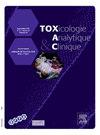Therapeutic drug monitoring of β-lactam antibiotics
IF 1.7
Q4 TOXICOLOGY
引用次数: 0
Abstract
Therapeutic drug monitoring (TDM) of antimicrobials is most commonly performed for compounds with narrow therapeutic-toxic windows, like glycopeptides and aminoglycosides. While β-lactam (BL) antibiotics are generally considered to have low toxicity, growing evidence indicates that TDM of BLs is necessary to ensure therapeutic efficacy. BLs are frequently used to treat severe infections in intensive care unit (ICU) patients, where significant pharmacokinetic and pharmacodynamic variability can lead to unpredictable BL concentrations. Despite the increasing amount of literature supporting the relevance of TDM for BLs, its implementation in routine clinical care remains sparse. This presentation will review the current state-of-the-art of TDM for BL, address the challenges associated with BL measurements, and propose potential solutions to address these issues.
A first challenge is the instability of BLs in biological fluids during the pre-analytical phase. For example, meropenem and piperacillin are stable for only 4 hours at room temperature or 6 hours at 4° C. As a result, strict pre-analytical conditions are required, which adds complexity, especially since only a few laboratories perform these measurements. This necessitates sending samples to analyzing labs using non-standard transport methods.
Another challenge is that BLs are primarily administered to critically ill patients, where rapid measurements with short turnaround times are crucial for timely dose adjustments, ultimately leading to better treatment outcomes. However, unlike for the glycopeptides and aminoglycosides, no such straightforward and fast methods are currently available. BLs in plasma are typically measured using in-house developed multi-analyte LC-MS methods.
Furthermore, most labs measure total BL concentrations in plasma rather than unbound (free) concentrations, as the latter require more complex and challenging procedures. However, it is the unbound drug that reaches the site of infection and exerts the pharmacological activity. Measuring free concentrations is particularly important for compounds that are highly-protein bound, such as flucloxacillin and ceftriaxone, where small changes in protein levels can lead to significant changes in free drug concentrations. If the ratio of free versus total concentration remains constant within a patient, total concentrations can serve as surrogate markers. However, this is generally not the case for ICU patients, where substantial variability in protein binding is observed.
In addition to the total versus free debate, it is assumed that tissue concentrations at the site of infection determine the antibiotic efficacy. However, for most infections, obtaining tissue samples at the target site is challenging, and when available, the analytical procedures for measurement of these matrices are far from straightforward. The measurement of BL in abdominal fluid, cerebrospinal fluid and exhaled breath has been described in the literature.
In conclusion, to fully realize the potential of TDM in optimizing BL antimicrobial therapy, accurate, fast, and reliable measurements of (free) concentrations are needed.
β-内酰胺类抗生素的治疗药物监测
抗微生物药物的治疗性药物监测(TDM)最常用于具有狭窄治疗毒性窗口的化合物,如糖肽和氨基糖苷。虽然人们普遍认为β-内酰胺类抗生素毒性较低,但越来越多的证据表明,β-内酰胺类抗生素的TDM是确保治疗效果的必要条件。BL经常用于治疗重症监护病房(ICU)患者的严重感染,其中显著的药代动力学和药效学变异性可能导致不可预测的BL浓度。尽管越来越多的文献支持TDM与bl的相关性,但其在常规临床护理中的实施仍然很少。本报告将回顾当前用于BL的TDM技术,解决与BL测量相关的挑战,并提出解决这些问题的潜在解决方案。第一个挑战是生物液体在分析前阶段的不稳定性。例如,美罗培南和哌拉西林在室温下只能稳定4小时,在4℃下只能稳定6小时。因此,需要严格的分析前条件,这增加了复杂性,特别是因为只有少数实验室进行这些测量。这就需要使用非标准的运输方法将样品送到分析实验室。另一个挑战是,BLs主要用于危重患者,在这种情况下,快速测量和短周转时间对于及时调整剂量至关重要,最终导致更好的治疗结果。然而,与糖肽和氨基糖苷不同,目前还没有这种直接快速的方法可用。血浆中的BLs通常使用内部开发的多分析物LC-MS方法进行测量。此外,大多数实验室测量血浆中总BL浓度,而不是非结合(游离)浓度,因为后者需要更复杂和具有挑战性的程序。然而,它是未结合的药物到达感染部位并发挥药理活性。测量游离浓度对于高度蛋白质结合的化合物尤其重要,如氟氯西林和头孢曲松,其中蛋白质水平的微小变化可导致游离药物浓度的显著变化。如果患者体内游离浓度与总浓度的比值保持不变,总浓度可以作为替代标记物。然而,对于ICU患者,情况通常并非如此,在ICU患者中观察到蛋白质结合的实质性变化。除了总量与游离量的争论外,人们还假设感染部位的组织浓度决定了抗生素的疗效。然而,对于大多数感染,在目标部位获得组织样本是具有挑战性的,并且当可用时,测量这些基质的分析程序远非直截了当。测量腹部液体、脑脊液和呼出气体中的BL已在文献中描述。总之,为了充分发挥TDM在优化BL抗菌治疗中的潜力,需要准确、快速、可靠地测量(游离)浓度。
本文章由计算机程序翻译,如有差异,请以英文原文为准。
求助全文
约1分钟内获得全文
求助全文

 求助内容:
求助内容: 应助结果提醒方式:
应助结果提醒方式:


